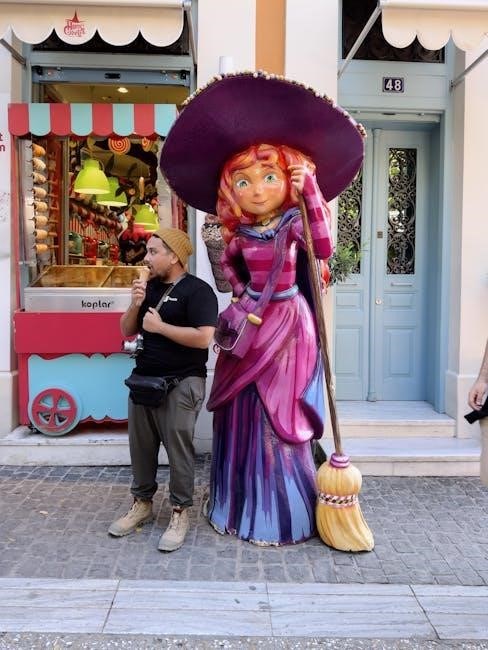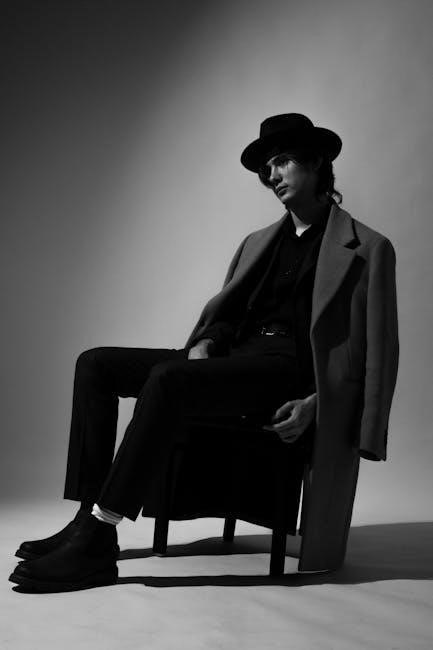
mens hat size guide
Discover the perfect fit with our comprehensive guide to men’s hat sizes. Learn how to measure your head, understand numerical and alphabetical sizing, and explore factors affecting fit for optimal style and comfort.
Overview of Hat Sizing
Hat sizing is based on head circumference, typically measured in inches or centimeters. Men’s hats are usually available in numerical sizes (e.g., 6 3/4 to 8) or alphabetical sizes (S, M, L, XL, XXL, XXXL). Some hats are labeled as “one size fits most,” designed to fit heads with a circumference of 21.5 to 23 inches. Numerical sizes are more precise, while alphabetical sizes provide a broader fit range. Standard hat sizes vary slightly by manufacturer but generally align with common measurements. For example, a medium hat typically fits a 22-inch head, while a large fits 22.5 inches. Understanding these sizing conventions helps ensure a comfortable and stylish fit, whether you’re choosing a fedora, baseball cap, or other styles. Always refer to the specific size chart for the best results.
Importance of Proper Fit
A well-fitting hat ensures both comfort and style, making it essential for any occasion. A hat that is too tight can cause discomfort or even headaches, while one that is too loose may not stay in place, especially in windy conditions. Proper fit enhances the overall appearance, creating a polished and put-together look. Hats that fit correctly are more likely to stay in place, maintaining their shape and providing the intended functionality, whether it’s sun protection or aesthetic appeal. Additionally, proper sizing prevents issues like shifting or slipping, which can distract from the hat’s intended purpose. Ensuring a precise fit also accounts for factors like hair thickness or head shape, making the wearing experience more enjoyable. Investing time in finding the right size guarantees a hat that feels great and looks its best, elevating both practicality and personal style.

How to Measure Your Head Size
To determine your hat size, wrap a flexible tape measure or string around the widest part of your head, just above your eyebrows and ears, ensuring a snug but comfortable fit.
Using a Tape Measure
To accurately measure your head size for a hat, use a flexible tape measure. Wrap it around the widest part of your head, just above your eyebrows and ears, ensuring it’s snug but not tight. Hold the tape measure level and parallel to the floor. The measurement should be taken where the hat will naturally sit. If the tape measure isn’t available, a string can be used as an alternative—wrap it around your head, mark the overlap point, and measure the length with a ruler. Record the measurement in inches or centimeters and refer to a hat size chart to find your corresponding size. Proper alignment and snugness are key to ensuring the measurement reflects your true hat size. This method ensures a precise fit, whether you’re shopping for fedoras, baseball caps, or other styles.
Alternative Methods for Measurement
If a tape measure isn’t available, alternative methods can still provide accurate results. Use a piece of string or a flexible cord to wrap around your head, marking where the ends meet with a pen or finger. Lay the string flat and measure its length with a ruler to determine your head circumference. Another method is to try on hats in a store to identify your size, then apply this knowledge to future purchases. Additionally, you can use a well-fitting hat as a reference by measuring its interior circumference. These approaches ensure precision even without specialized tools. Remember, the goal is to achieve a snug, comfortable fit that aligns with standard hat sizing charts. By exploring these alternatives, you can confidently determine your size and enjoy a perfectly fitted hat.
Tips for Accurate Measurement
Ensuring an accurate head measurement is crucial for the perfect hat fit. Keep the tape measure snug but not overly tight, as this can lead to discomfort and an ill-fitting hat. Position the tape consistently, either just above the eyebrows and ears or at the widest part of your head, depending on the hat style. Use a mirror to verify the tape is level and not tilted, which could distort the measurement. Measure multiple times to confirm accuracy, as slight variations can occur. If your head size falls between two sizes, opt for the larger size to avoid a tight fit. Consider your hair thickness, as a hat may fit differently depending on your hairstyle or if you wear it under a hat. Finally, account for material shrinkage or stretching, as some hats may change size over time. These tips ensure a precise and comfortable fit for your chosen hat.

Understanding Hat Size Charts
Mastering hat size charts ensures a perfect fit. Charts typically feature numerical, alphabetical, or one-size-fits-most options, with sizes correlating to head circumference measurements in inches or centimeters for accuracy.
Numerical Hat Sizes
Numerical hat sizes are the most common system for men, ranging from 6 3/4 to 8. These sizes correspond to head circumferences measured in inches, typically in 1/8 increments. For instance, a size 7 hat fits a 22-inch head, while a 7 1/8 fits a 22.25-inch circumference. To determine your numerical size, measure around your head just above the eyebrows and ears. If your measurement falls between sizes, opt for the next larger size for comfort. This system ensures precision, especially for those with larger heads, as sizes go up to XXL and XXXL. Always refer to a hat size chart to convert your head measurement into the correct numerical size for the best fit.
Alphabetical Hat Sizes
Alphabetical hat sizes, such as Small, Medium, Large, and Extra Large, provide a straightforward sizing system for men. These sizes correspond to specific head circumferences, with Medium typically fitting heads measuring 21.5 to 22.5 inches and Large accommodating 22.5 to 23.5 inches. XL sizes are designed for larger heads, often ranging from 23.5 to 24.5 inches. Some hats are labeled as “One Size Fits Most,” suitable for heads between 21.5 and 23 inches. Adjustable features like drawstrings or sweatbands allow for a customizable fit. While not as precise as numerical sizing, alphabetical sizes offer convenience. For those with larger heads, XXL and XXXL options are available, ensuring comfort and style for all. Always check the size chart to match your head measurement with the appropriate alphabetical size for the best fit.
International Size Conversions

Understanding international hat size conversions is essential for men shopping across borders or online. US hat sizes are numerical, while UK sizes often align closely with US measurements. European sizes are typically measured in centimeters, reflecting head circumference. For example, a US size 7 1/4 (22.75 inches) corresponds to a UK size 7 1/4 and a European size 58cm. A large alphabetical size in the US generally fits heads measuring 22.5 to 23.5 inches, equivalent to a UK size 7 1/2 to 7 3/4 or a European size 59cm to 60cm. Converting sizes ensures a proper fit, especially when purchasing from international brands. Always refer to the specific size chart provided by the manufacturer, as slight variations may occur. This guide helps men navigate size differences seamlessly, ensuring the perfect fit regardless of the region or brand.

Factors Affecting Hat Fit
Hat fit is influenced by material, head shape, and hair. Felt hats may fit tighter than straw hats, while round heads suit different styles than oval shapes. Hair thickness also impacts comfort and sizing.
Material and Hat Type
The material and type of hat significantly impact its fit. Felt hats, like fedoras, tend to be more rigid and may require a precise fit, while straw hats, such as Panamas, are often more flexible. Hats made from natural fibers like wool or cotton can stretch slightly over time, whereas synthetic materials maintain their shape more consistently. Additionally, certain styles, such as baseball caps or beanies, are designed to fit snugly, while others, like sun hats, may have a looser fit for comfort. Understanding the material and style helps in selecting a hat that not only fits well but also meets your lifestyle needs.
Head Shape and Hair Considerations
Your head shape and hairstyle can influence how a hat fits and looks. For example, individuals with rounder heads may prefer hats with angular or structured designs, like fedoras, to balance their features. Those with oval-shaped heads can pull off a wide variety of styles. Hair length and thickness also play a role; men with longer or thicker hair may need a slightly larger hat size to accommodate their hairstyle comfortably. Additionally, hats with adjustable straps or drawstrings can provide a more customizable fit, ensuring comfort regardless of hair texture or head shape. Considering these factors ensures a hat not only fits well but also complements your personal style and grooming.

Adjusting Your Hat Size
Easily customize your hat fit with sizing tape or drawstrings. These tools allow adjustments for comfort, ensuring your hat stays secure without compromising style or causing discomfort.
Using Sizing Tape and Drawstrings

Adjusting your hat size is simple with sizing tape and drawstrings. Many hats feature an inner drawstring stitched into the sweatband, allowing you to tighten the fit by up to two sizes. For hats without drawstrings, sizing tape is a practical solution. This foam-backed tape is placed under the sweatband to create a snug, customized fit. Unlike other methods, sizing tape maintains the sweatband’s shape without causing damage. Some retailers even provide sizing tape free with purchases, ensuring a perfect fit. Whether you prefer drawstrings or sizing tape, these tools ensure your hat stays comfortable and secure, adapting to your head shape for long-lasting wear. This method is especially useful for hats that are slightly too large, providing a tailored fit without compromising style.
Caring for Your Hat to Maintain Fit
Proper care is essential to maintain your hat’s fit and longevity. For straw and felt hats, avoid excessive exposure to moisture, as it can cause shrinkage or stretching. Use a soft cloth to gently remove dirt or dust. For leather hats, condition regularly to prevent cracking. Avoid direct sunlight, as it can fade colors or warp the material. Store your hat in a cool, dry place, using a hat box or bag to protect it from dust and deformation. Avoid squeezing or bending the hat, as this can alter its shape. Cleaning should be done sparingly, using specific products for the material. Regular maintenance ensures your hat retains its shape and fit, providing years of comfort and style. By following these care tips, you can enjoy your hat’s perfect fit season after season.

Common Hat Styles and Their Size Ranges
Explore popular men’s hat styles, each with unique size ranges. From fedoras and panamas to baseball caps and truckers, understanding their sizing ensures a perfect fit for every occasion and preference.
Fedora and Panama Hats
Fedora and Panama hats are timeless choices for men, offering both style and functionality. Fedoras, typically made from felt or straw, feature indented crowns and wide brims, ideal for formal or semi-formal occasions. Panama hats, crafted from woven straw, are lightweight and perfect for summer, often associated with a more casual yet elegant look. Both styles generally range in sizes from 6 3/4 to 8 in numerical sizing or small to extra-large in alphabetical sizing. When fitting, ensure the hat sits comfortably above the eyebrows, with the brim parallel to the ground. The right size ensures a balanced look and prevents slipping. These hats are versatile, suiting various face shapes and personal styles, making them a staple in many wardrobes. Proper care, like avoiding extreme heat or moisture, will extend their lifespan and maintain their shape.
Baseball Caps and Trucker Hats
Baseball caps and trucker hats are popular for their casual style and versatility. These hats typically feature adjustable closures like Velcro straps or snapbacks, ensuring a one-size-fits-most fit. They usually range in sizes from 6 3/4 to 8 or small to extra-large, depending on the brand. Designed for comfort, they often have breathable materials like cotton, polyester, or mesh panels. Trucker hats, with their foam fronts and mesh backs, are particularly lightweight and ideal for summer; Baseball caps are sports-inspired and often feature logos or embroidery. Both styles are easy to care for—spot clean or hand wash to maintain shape and color. These hats are perfect for everyday wear, offering a relaxed fit that suits most head sizes. Their adjustable design makes them a practical choice for various occasions, from sports events to casual outings.

Frequently Asked Questions
Can hats be stretched or shrunk? Yes, some materials like leather can be stretched, while others like cotton may shrink slightly. Average men’s hat sizes range from 7 1/4 to 7 3/8.

Can Hats Be Stretched or Shrunk?
Hats can often be adjusted to fit better, but the method depends on the material. Felt hats can be gently stretched using steam or a hat stretcher, while leather hats may require conditioning to soften and shape. Cotton or canvas hats can sometimes shrink slightly when washed, but this isn’t recommended. Hats made from natural fibers like straw or wool may also be reshaped carefully. However, not all hats are easily adjustable, and some materials, like synthetic fabrics, may not respond well to resizing. For one-size-fits-most hats, features like drawstrings or sizing tape can help achieve a better fit without altering the hat itself. Always check the manufacturer’s guidelines before attempting to stretch or shrink a hat to avoid damage.
Average Hat Sizes for Men
The average hat size for men typically falls between 7 1/4 to 7 3/8, corresponding to a head circumference of approximately 22 3/4 to 23 inches. This range is considered standard for most men’s hats, ensuring a comfortable and stylish fit. However, hat sizes can vary slightly depending on the manufacturer and material. For example, felt hats may fit tighter initially but can stretch over time, while straw hats tend to remain consistent in size. Factors such as head shape and hair thickness can also influence how a hat fits. To ensure the best fit, it’s essential to measure your head accurately and refer to the specific size chart provided by the manufacturer. Remember, hats are designed to sit comfortably above the eyebrows and ears for optimal style and comfort.
Finding the perfect hat size is a straightforward process when guided by the right measurements and understanding of sizing charts. By accurately measuring your head circumference and comparing it to numerical or alphabetical sizes, you can ensure a comfortable and stylish fit. Remember, hats are not just about style but also about comfort, so the fit should be snug but not tight. Whether you prefer classic fedoras, casual baseball caps, or versatile panama hats, the right size ensures optimal wearability. Don’t hesitate to explore different styles and materials to find what suits you best. With proper care and adjustments, your hat will remain a reliable accessory for years to come. Refer back to this guide for future purchases and enjoy the confidence that comes with a well-fitted hat.
Related posts:
Archives
Calendar
| M | T | W | T | F | S | S |
|---|---|---|---|---|---|---|
| 1 | 2 | |||||
| 3 | 4 | 5 | 6 | 7 | 8 | 9 |
| 10 | 11 | 12 | 13 | 14 | 15 | 16 |
| 17 | 18 | 19 | 20 | 21 | 22 | 23 |
| 24 | 25 | 26 | 27 | 28 | 29 | 30 |
Leave a Reply
You must be logged in to post a comment.